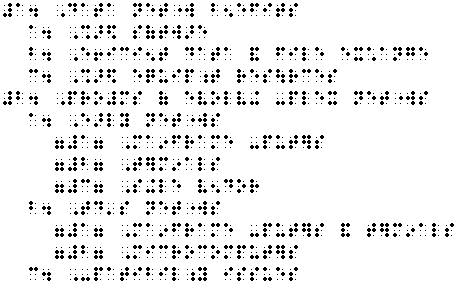|
Outlines are relatively straight-forward. The print copy is followed for outline indicators and numbers. Note that the letter sign is not required for outline letters that are in contact with punctuation or enclosure marks.
In the outline, main entries start in Cell 1, with runovers in Cell 3 if there are no subitems. If there are subitems, main entries start in Cell 1 with runovers in Cell 5, subitems begin in Cell 3 with runovers in Cell 7, sub-entries in Cell 5 with runovers in Cell 9, etc. There are no blank lines between entries.
The Code indicates that some texts (like the Code itself) are often printed in their entirety as outlines. Many instructional manuals come in this format. For these texts:
each main division begins in Cell 3
indent two (2) cells for the beginning of subdivisions
ALL runovers begin in Cell 1
a braille page guide must be centered on the last line of the braille page. This page guide should list the last outline division on the page. For example, if the last item was in Chapter 4, with the last division being Section 2a(2), the braille page guide would read "Chapter 4, §2a(2)."
A simple example of an outline and the accompanying braille is shown below:
- Data network benefits
- Shared software
- Efficient data and file exchange
- Shared equipment resources
- Problems of evolving complex networks
- Early networks
(1) Mainframe computers
(2) Terminals
(3) Single vendor
- Today's networks
(1) Mainframe computers and terminals
(2) Microcomputers
- Compatibility issues

|